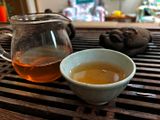I have a bit of help from some tea friends, who are helping separate the crap from the gold. One of them has been singing the praises of sample C, which I don't recall too specifically, only that it wasn't too bad. One of my favorites so far has been sample B, which is a'02 boxed version of the Jia Ji Tuo Cha. I don't know about the differences between the boxed and non-boxed versions, but the boxed versions are usually more expensive than their non-boxed counterparts.
The Dry Leaf

On the left is the 2001 Non-Boxed Xiaguan Jia Ji Tuo Cha, and on the right is the 2002 Boxed Xiaguan Jia Ji Tuo Cha
Nothing remarkable about the dry leaf really; they both smelled fairly similar, except the '02 Non-Boxed version has a weird cotton candy-like aroma. I tried to maintain the integrity of the leaves, while making sure it isn't in too large of chunks, because that way they can both evenly.
The Tea Brew
 So because of my idiocy, the one on the left is the boxed version, and the right is the non-boxed
So because of my idiocy, the one on the left is the boxed version, and the right is the non-boxed
 So because of my idiocy, the one on the left is the boxed version, and the right is the non-boxed
So because of my idiocy, the one on the left is the boxed version, and the right is the non-boxedOnce again, not too many differences in the brew, even in the color. Clarity was pretty good in both of them, and they both brewed up a similar amber-gold. Although there is roughness of bitterness/astringency, it seems that it's been mellowed out by age. Although compression was tight, it was slightly looser with the boxed version, which makes me more inclined to buy that version. Sample B seemed a little rougher, but I found it charming because it seemed that the tea had more character, whereas its counterpart was a bit flatter. With both of them, but especially with sample B, the astringency translated into a lasting and decent hui gan, something I value highly. Sample C seemed a little mellower, which may be the result of an additional year of aging, but it also seemed boring. Now, comparing competition style is only one facet of all of this...and I'll see if all of this translate when brewing it normally. So far so good with all of the samples, and at least to my palate it doesn't seem like any of them are fakes. They're good to drink now, with some exception, but if they aged well it could be something marvelous. I think they fall within my expectations, considering their price (roughly $10-$12 a pop).
 Not much to see here, just your run of the mill factory chopped leaf. Surprisingly, there aren't too many differences in terms of aging, IMO. Of course, they're only one year apart so perhaps there wouldn't be any difference, but because the box would deter aging, I suspect that the boxed versions are stored box-less, and put back into the box for sale. Much chance for a switch-a-roo, but 2002 isn't really a big selling point, but who knows. Although not as nice as the 2002 Mengku cake I also ordered, but at a better price-point, I can buy more for storage.
Not much to see here, just your run of the mill factory chopped leaf. Surprisingly, there aren't too many differences in terms of aging, IMO. Of course, they're only one year apart so perhaps there wouldn't be any difference, but because the box would deter aging, I suspect that the boxed versions are stored box-less, and put back into the box for sale. Much chance for a switch-a-roo, but 2002 isn't really a big selling point, but who knows. Although not as nice as the 2002 Mengku cake I also ordered, but at a better price-point, I can buy more for storage.
The Wet Leaf
 Not much to see here, just your run of the mill factory chopped leaf. Surprisingly, there aren't too many differences in terms of aging, IMO. Of course, they're only one year apart so perhaps there wouldn't be any difference, but because the box would deter aging, I suspect that the boxed versions are stored box-less, and put back into the box for sale. Much chance for a switch-a-roo, but 2002 isn't really a big selling point, but who knows. Although not as nice as the 2002 Mengku cake I also ordered, but at a better price-point, I can buy more for storage.
Not much to see here, just your run of the mill factory chopped leaf. Surprisingly, there aren't too many differences in terms of aging, IMO. Of course, they're only one year apart so perhaps there wouldn't be any difference, but because the box would deter aging, I suspect that the boxed versions are stored box-less, and put back into the box for sale. Much chance for a switch-a-roo, but 2002 isn't really a big selling point, but who knows. Although not as nice as the 2002 Mengku cake I also ordered, but at a better price-point, I can buy more for storage.











